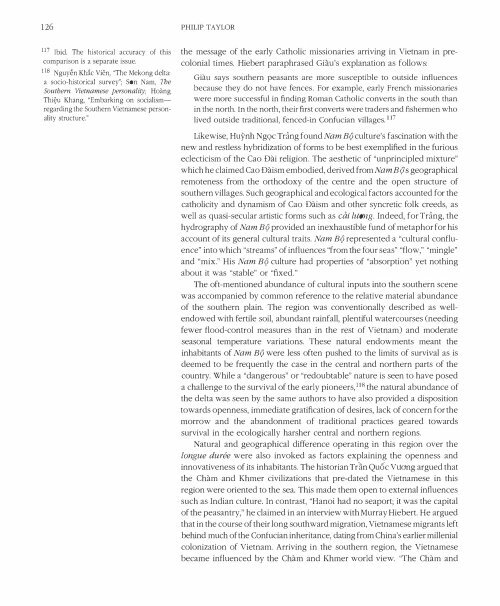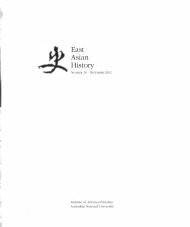(Philip Taylor) (PDF 3.1MB) - ANU
(Philip Taylor) (PDF 3.1MB) - ANU
(Philip Taylor) (PDF 3.1MB) - ANU
Create successful ePaper yourself
Turn your PDF publications into a flip-book with our unique Google optimized e-Paper software.
126<br />
PHILIP TAYLOR<br />
117 Ibid. The historical accuracy of this<br />
comparison is a separate issue.<br />
liS<br />
Nguyn Khac Vien, "The Mekong delta:<br />
a socio-historical survey"; San Nam, The<br />
Southern Vietnamese personality; Hoang<br />
Thiu Khang, "Embarking on socialismregarding<br />
the Southern Vietnamese personality<br />
structure."<br />
the message of the early Catholic missionaries arriving in Vietnam in precolonial<br />
times. Hiebert paraphrased GilU's explanation as follows:<br />
Giau says southern peasants are more susceptible to outside influences<br />
because they do not have fences. For example, early French missionaries<br />
were more successful in finding Roman Catholic converts in the south than<br />
in the north. In the north, their first converts were traders and fishermen who<br />
lived outside traditional, fenced-in Confucian villages. 117<br />
Likewise, Huynh Ng9c Trang found Na m B{) culture's fascination with the<br />
new and restless hybridization of forms to be best exemplified in the furious<br />
eclecticism of the Cao Dai religion. The aesthetic of "unprincipled mixture"<br />
which he claimed Cao Daism embodied, derived from Na mB{)'s geographical<br />
remoteness from the orthodoxy of the centre and the open structure of<br />
southern villages. Such geogra phi cal and ecological factors accounted for the<br />
catholicity and dynamism of Cao Daism and other syncretic folk creeds, as<br />
well as quasi-secular artistic forms such as cai luang. Indeed, for Trang, the<br />
hydrography of Na m B{) provided an inexhaustible fund of metaphor for his<br />
account of its general cultural traits. Na m B{) represented a "cultural confluence"<br />
into which "streams" of influences "from the four seas" "flow," "mingle"<br />
and "mix." His Na m B{) culture had properties of "absorption" yet nothing<br />
about it was "stable" or "fixed."<br />
The oft-mentioned abundance of cultural inputs into the southern scene<br />
was accompanied by common reference to the relative material abundance<br />
of the southern plain. The region was conventionally described as wellendowed<br />
with fertile soil, abundant rainfall, plentiful watercourses (needing<br />
fewer flood-control measures than in the rest of Vietnam) and moderate<br />
seasonal temperature variations. These natural endowments meant the<br />
inhabitants of Na m B{) were less often pushed to the limits of survival as is<br />
deemed to be frequently the case in the central and northern parts of the<br />
country. While a "dangerous" or "redoubtable" nature is seen to have posed<br />
a challenge to the survival of the early pioneers, 118 the natural abundance of<br />
the delta was seen by the same authors to have also provided a disposition<br />
towards openness, immediate gratification of desires, lack of concern for the<br />
morrow and the abandonment of traditional practices geared towards<br />
survival in the ecologically harsher central and northern regions.<br />
Natural and geographical difference operating in this region over the<br />
longue duree were also invoked as factors explaining the openness and<br />
innovative ness of its inhabitants. The historian Tr'an Quac Vuong argued that<br />
the Cham and Khmer civilizations that pre-dated the Vietnamese in this<br />
region were oriented to the sea. This made them open to external influences<br />
such as Indian culture. In contrast, "Hanoi had no seaport; it was the capital<br />
of the peasantry," he claimed in an interview with Murray Hiebert. He argued<br />
that in the course of their long southward migration, Vietnamese migrants left<br />
behind much of the Confucian inheritance, dating from China's earlier millenial<br />
colonization of Vietnam. Arriving in the southern region, the Vietnamese<br />
became influenced by the Cham and Khmer world view. "The Cham and
















